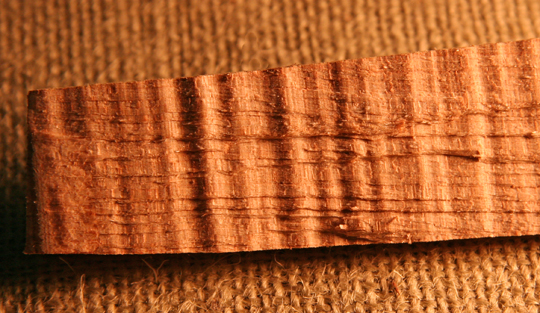|
A long time ago I was a forestry major in college and
actually wrote a research paper on curly wood for a wood
technology class. I do not have the paper any longer but
here is the summary. By the late 1960s the Germans
(leaders in scientific approaches to forestry) had
published research showing that 40% of the progeny of
two curly trees would be curly. (If it was a dominant
gene all the progeny would be curly.) That is why when
you find a curly tree in the woods you should look at
all the other maples in the immediate neighborhood. They
all came from the same parent stock so curly trees do
occur together– and that has probably lead to the myth
that where the tree grows causes it to be curly.
The heredity is a lot like the gene that causes curly
hair on people. Anything from a slight wave to real
kinky. Note that not all the hair on a person has the
same amount of curl, likewise, wood in different parts
of the same tree have different amounts of curl! Some of
the extremely curly trees are curly all the way up into
the limbs but most are not.
In wood curl shows up as some form of wave pattern to
the fibers. The wave can vary in amplitude (height) and
frequency (spacing). The higher the amplitude the more
the curl will show as a stripe when stained or even just
finished. Curl can also run in different directions.
Peel the bark on a curly tree and the curl can be like a
washboard with the waves going in and out on the radius
(toward the heart of the tree) OR it can be a wave that
is 90 degrees to the radius or in the plane of a tangent
(much more subtle because you have to look at the fibers
of the wood to see them waving back and forth) . Most
curl has some of both components.

There are also two kinds of curl that are not
hereditary. The “crotch grain” wood occurs (naturally)
in the crotch where a tree forks or a big limb comes
off. It is caused by wrinkling of the wood fibers as the
two limbs both increase in diameter. Each year a new
annual ring tries to squeeze into the remaining space.
The correct term for this kind of curl in compression
wood. The same thing happens at the swell where the
trunk flows in to the roots. If you look at a smooth
barked tree you can see wrinkles on the outside of the
stump swell where the wood is being compressed.
True burl wood is not curl. Burl is formed by growths on
the tree that look like huge warts. They are caused
abnormal division of advantageous growth cells. Those
growth cell normally serve as a way for a tree to sprout
new limbs when that is to the trees "advantage." You
will see new growth sprouting from the trunk of a tree
when cutting other trees exposes the trunk to sunlight.
A burl happens when these cells take on a cancer like
growth spurt.
(top)
|